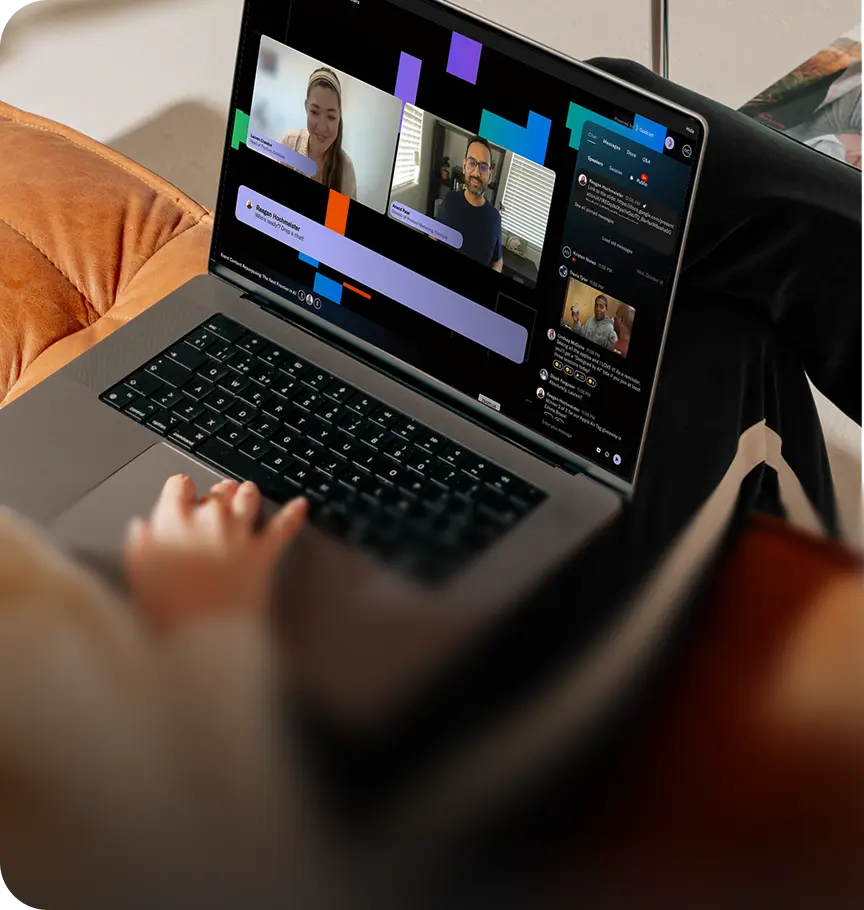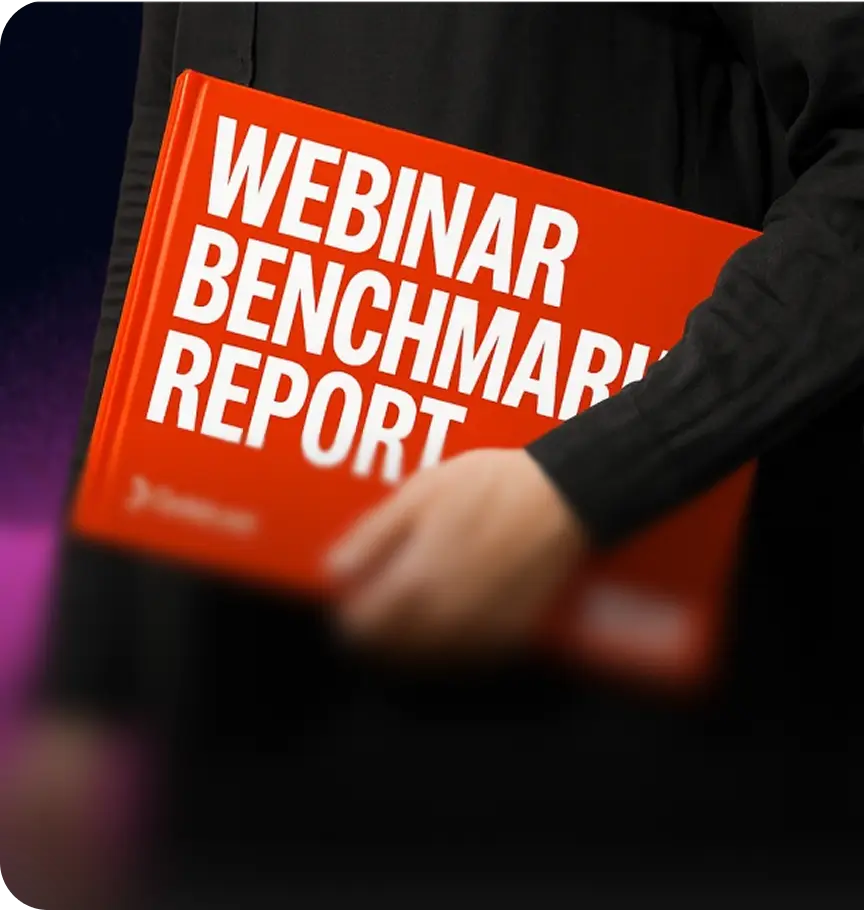How to Record a Podcast: A Guide from Creation and Distribution

Table of Contents
Maximize Your Marketing ROI
Join 10,000 other marketers already getting the best tips on running engaging events that boost pipeline and create raving fans.
Recording a podcast isn't rocket science. But thoughtfully creating each episode to achieve what you want it to—i.e. building your brand and engaging your audience? That takes more than just hitting "record."
Whether you're a seasoned B2B marketer or a beginner dipping your toes into audio content for the first time, this comprehensive guide will walk you through everything you need to know about creating a successful podcast. From topic planning and recording equipment to distribution strategies, we've got you covered.
And here's the best part: In our increasingly AI-driven world, podcasts offer an authentic connection that’s invaluable for B2B brands looking to stand out. After all, anyone can post a ChatGPT-generated blog post—but not everyone can facilitate a compelling conversation that keeps listeners coming back for more.
“The thing that we’re really hungry for is authentic human connection,” reflects Rachel Elsts Downey, Founder & CEO of Share Your Genius. “The number one way to connect somebody with somebody is through conversation, and podcast, specifically, is the channel to do that in a very authentic way.”
How to record a podcast: 10-step guide
Wondering how to take your podcast from vision to reality? Let's break down the process into manageable steps you can start today.
For even more detail, check out our comprehensive tutorial, How to Start a Podcast.
1. Identify your target audience
The foundation of any successful podcast is a clear understanding of who you're creating content for. Here’s a hint: If your podcast is designed to appeal to everyone, it’s probably not going to land with anyone.
For B2B podcasts, identifying your target audience means laying out:
- Job titles and roles you want to reach
- Industries and company sizes
- Specific pain points and challenges they face
- Content preferences and consumption habits
Creating detailed listener personas helps ensure your podcast resonates with the right people and, yes, sends the wrong people on their way.
For B2B podcasts, consider developing content themes aligned with specific buyer journey stages or addressing audience pain points at different organizational levels. The best podcasts find the sweet spot between what their audience wants to learn and what their brand is uniquely qualified to speak to.
2. Choose a compelling topic and brand
With your audience defined, it's time to select a topic that delivers value while showcasing your brand's expertise. Your podcast topic should:
- Address specific industry challenges
- Align with your company's core competencies and product roadmap
- Fill a content gap in your industry
- Remain relevant over time
- Provide a fresh perspective on familiar issues
For example, if your brand is a marketing SaaS, you might focus on measuring marketing ROI or marketing technology integration stories rather than general marketing tips.
As Seth Godin famously said in his Bootstrapper’s Bible, “Find a niche, not a nation.”
Then, build a distinctive brand upon your chosen topic. With thousands of business podcasts competing for attention, it’s important to get your podcast branding right:
- Develop a unique podcast name that conveys your focus
- Create professional, recognizable cover art
- Establish a consistent sound with intro/outro music
- Define your podcast's unique angle or perspective
- Maintain consistent voice and tone across episodes
Your podcast should feel like a natural extension of your brand while offering something listeners can't get elsewhere. Think of it as your brand's personality, held up to a microphone. 🎙️
3. Get your gear
You don't need a professional studio to create a quality podcast, but investing in the right podcast equipment makes a significant difference in production value. Here's an overview of the podcast recording equipment you’ll need:

🛑 Wait, why do I need a camera and lighting? I thought podcasts were audio-only??
Strictly speaking, you can produce an audio-only podcast. However, honestly, you’d be leaving a lot on the table.
A video element is quickly becoming table stakes for B2B podcasts:
- YouTube is now the most popular platform for podcast consumption, surpassing Spotify and Apple Podcasts.
- The #2 reason people don’t listen to podcasts is that they prefer watching videos over listening.
This trend is even more pronounced in the B2B space, where visual elements can help explain complex concepts.
If recording video sounds intimidating or like a lot of work, rest assured: It’s really not. Capturing video doesn't require much additional gear for your podcast setup—a decent webcam or smartphone camera will work for starters.
4. Choose your podcast format
Other than our strong suggestion to include video, there's no one-size-fits-all approach to podcast formats. The right structure depends on your goals, content, and audience preferences. Here are a few common formats:
- Interview: Featuring industry experts or customers; ideal for thought leadership
- Panel discussions: Multiple guests discussing a specific topic; great for presenting diverse viewpoints
- Solo episodes: Host-driven content that establishes your brand's authority
- Co-hosted shows: Conversational format with consistent co-hosts; creates familiarity
- Storytelling: In-depth exploration of case studies or customer journeys
The interview format is the most common in B2B, but don't be afraid to experiment with different approaches or mix formats throughout your season.
Different audiences respond to different podcast structures. Consider how your target listeners prefer to consume content. For example:
- Time-strapped executives may prefer shorter, focused episodes. If your target audience includes CMOs, they're probably checking email during your podcast. Brevity is your friend.
- Technical practitioners might engage with longer, detailed discussions.
- Some audiences value consistency in episode length and format, while others might prefer variety.
Monitor engagement metrics to understand what resonates with your specific audience, and then adjust accordingly.
5. Find and book great guests
If you're planning an interview-style podcast, your guests can make or break your show. Great guests cement your authority and expand your reach. To find and book the perfect guests:
- Research thoroughly before extending invitations
- Explain clearly how the podcast benefits their personal brand
- Make the recording process as convenient as possible
- Prepare customized questions that showcase their expertise
- Offer promotional support when the episode launches
Remember, the best guests aren't necessarily the ones with the most followers. They're the ones with the most relevant insights for your audience. That industry titan might have name recognition, but the mid-level manager with hands-on experience often delivers more practical value to your listeners. ✅
6. Script your podcast
While natural conversation creates an engaging podcast, structure ensures your episodes stay focused and valuable. Create a flexible “script” that includes:
- Engaging intro that introduces the topic and guest
- Clear episode outline with key questions
- Transitions between segments
- Consistent outro with call to action
Your script should be guided by your podcast’s primary goal, which, as Rachel explains, is typically one of three:
- Brand authority: Showcase your expertise & thought leadership
- Demand generation: Build strategic relationships & nurture prospects
- Audience growth: Expand your reach and engage consistently
For interview-based podcasts, prepare questions in advance but leave room for organic conversation. Share these questions with guests before you record so they know what to expect—but remind them that you’d rather them respond with their own natural language vs. reading a prepared response.
7. Record your podcast
Before you hit the record button, there are a few steps you can take to make sure you have optimal conditions for high-quality audio:
- Find a quiet space with minimal background noise
- Position your microphone properly (4-6 inches from your mouth)
- Test your equipment before the actual recording
- Record in a lossless format (.WAV rather than .MP3)
- Whether remote or in-person, use specialized software that captures separate tracks
For video podcasts, ensure proper lighting, clean backgrounds, and stable camera positioning. Recording a short test clip to check your setup can save hours of frustration later. (Or worse, having to ask your guest to re-record the whole thing. 😱)
For remote recording, we strongly recommend using podcast recording software designed specifically for this use case. Trying to capture the conversation in Zoom or Skype, then exporting it for editing and distribution truly isn’t worth the headache.
8. Edit your podcast
Authenticity is the backbone of a great podcast—but that doesn’t mean you should jump straight from recording to publishing. A bit of editing transforms your raw recording into a polished final product. Our top tips:
- Remove filler words, long pauses, and any technical issues
- Add intro and outro music
- Balance audio levels between speakers
- Include sound effects or transitions if appropriate
- Optimize sound quality (normalization, compression, EQ)
Quality editing makes your podcast sound professional. Just be sure to avoid over-editing. If your episode is full of jump cuts, it becomes hard to follow. Maintaining natural conversation flow is crucial for listener engagement.
9. Publish your podcast
Once your episode is ready, it's time to share it with the world. 🙌🏼 And how, exactly, do you do that? Here’s a step-by-step guide:
- Upload to a podcast hosting platform
- Create compelling episode titles and descriptions with relevant keywords
- Add detailed show notes with timestamps and resource links
- Design eye-catching cover art that matches your brand
- Distribute to major podcast directories
Consistency is key—establish a regular publishing schedule so your audience knows when to expect new content.
10. Promote and distribute your podcast
Creating a great podcast is only half the battle—you need promotion to build an audience. Here are a few winning strategies:
- Share episodes across your company's social media channels
- Include podcast episodes in your email marketing
- Create audiograms (short audio clips with visuals) for social sharing
- Cross-promote with complementary podcasts or partners
- Encourage podcast guests to share episodes with their networks
Don’t let your podcast exist in a void. Podcasts are a major source of unique brand angles and content nuggets. Integrate your podcast calendar with your broader content marketing strategy to amplify reach and engagement.
11. Repurpose and share your podcast
Your podcast is a gold mine of long-form content that can be repurposed into different formats for different channels. Don’t publish and walk away without a thoughtful repurposing strategy.
Repurposing your podcast maximizes ROI and helps you reach audiences who consume different content types. For example:
- Create blog posts from episode transcripts
- Extract key quotes for social media
- Develop short video clips for LinkedIn and other platforms
- Turn insights into infographics or slide decks
- Use key points in newsletters or email sequences
By transforming podcast content into multiple formats, you extend its life and reach while reinforcing key messages across channels. A single 30-minute podcast can generate dozens of assets that reach different segments of your target audience.
Curious about the power of podcast repurposing? Try Goldcast Content Lab for free and turn one hour of content into weeks of marketing assets.
Choosing the right software to manage your B2B podcast
Let’s talk tech. We covered several different technical processes above—recording, editing, publishing, and distributing.
Yep, you’re going to need software for those.
The tools you use can significantly impact your podcast's quality and your team's efficiency. The good news is that many platforms combine the different processes into a streamlined workflow.
Here's what to look for in podcast production software:
Recording capabilities
For recording your podcast, look for a platform that offers high-definition audio quality and reliability—as well as video capture. The best video podcast software typically offers:
- HD audio recording
- Synchronized video capture
- Remote multi-track guest recording
- Easy interface for non-technical team members
- Cloud storage for recordings
Editing features
The right podcast editing software meets you on your level of tech-savvy. If you have a dedicated editor, they’ll work well with a professional-grade editing tool, called a digital audio workstation or DAW.
If you’re one of those “wears many hats” marketers (hi, it’s us 👋🏼) who’ll be editing without technical training, there are intuitive tools out there for you, too—Audacity, for example, or even GarageBand if you’re a Mac person.
Look for features like:
- Basic audio file editing and enhancement
- Video editing capabilities
- Branding element integration
- Custom intro/outro addition
- Output in multiple formats
Publishing and distribution
How do you get your own podcast on Spotify and Apple? You need a podcast hosting platform, where your episodes will live and be automatically distributed to the major streaming sites. Look for solutions that streamline the publishing process with:
- Direct publishing to major podcast platforms
- Website embedding options
- Customizable RSS feeds
- Scheduling capabilities
- Analytics and performance tracking
Content repurposing
Maximize the ROI of your podcast with tools that help you easily repurpose its content. We’re talking activities like:
- Automated transcription
- Clip creation for social sharing
- Blog post generation
- Email content development
- Social media asset creation
Of course, as the aforementioned marketer of many hats, the last thing you need is to be juggling multiple tools to get your podcast published and promoted.
That’s why the ideal podcast platform integrates all these functions, reducing production time and headache.
Spoiler alert: We created it. Just for you.
Record, edit, publish and promote your podcast with Goldcast
Creating a professional podcast that achieves your business goals is easier than ever with Goldcast’s end-to-end suite of tools.
Goldcast's Recording Studio has everything you need to create stunning audio and video podcasts:
- HD recording that captures crystal-clear audio and video
- Simple remote podcast guest management for seamless interviews
- Professional branding elements to maintain visual identity
- Built-in video and audio editing tools for polishing your episodes
- Direct publishing to major podcast platforms
But recording is just the beginning. With Goldcast Content Lab, you can spin off each podcast episode into a collection of content assets that keep working for you:
- Automatically generate blog posts from your episodes
- Create social media clips highlighting key moments
- Develop email newsletters featuring podcast insights
- Extract quotes and talking points for repurposing
- Track performance across different content formats
The result: A streamlined workflow that turns an hour of recording into a polished podcast plus weeks of marketing content.
Ready to start recording? Schedule a demo to see how easy professional podcast production can be.
Transform Your Video Marketing with AI
Stay In Touch
Platform
Resources
© 2025 Copyright Goldcast, Inc. All rights reserved.





 Upcoming Events
Upcoming Events Event Series
Event Series On-Demand Events
On-Demand Events

